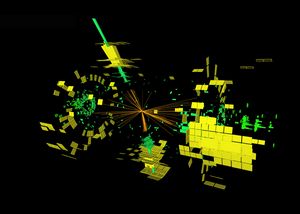
The goal of the ATLAS experiment is the investigation of the nature of the elementary particles and their interactions. All previous experimental observations of the particle world could be described with astounding accuracy through the Standard Model of particle physics. However, there are physical questions that lead one to suspect that this is not the ultimate fundamental theory of nature:
- Why do the elementary particles have different masses?
- Why is there more matter than antimatter in the universe?
- What is the dark matter observed in space made of?
- Is there supersymmetry?
The precise measurement of the Standard Model and the search for new, previously unknown particles will yield insights about new physical phenomena that are not described in the Standard Model. These are the issues that physicists at the MPP are concerned with. To that end, they analyze the proton-proton impacts that are produced in the Large Hadron Collider (LHC) and recorded with the ATLAS detector.
Precise measurement of the Standard Model
With the discovery of the Higgs boson in 2012, the last building block of the Standard Model was experimentally verified. Precision measurements of the properties of the Higgs boson and other known physical processes make it possible to check how internally coherent Standard Model is. With that, it will be possible to constrain the possible theoretical extensions of the Standard Model.
- Physics of the top quark: The top quark is the heaviest particle of the Standard Model, nearly as heavy as a gold atom. Its properties decisively influence the predictions of theoretical models ranging from Higgs boson physics to the inflation following the Big Bang and the stability of the vacuum.
- Physics of the W and Z bosons: The W and Z gauge bosons are carrier particles of the electroweak force, which are generated uniquely at the LHC in large quantities. These production processes can, at high energies, be influenced by new, previously unknown particles and thus indicate deviations from the Standard Model.
- Physics of the Higgs boson: The recently discovered Higgs boson is the central element of the so-called Higgs mechanism, which is responsible for the masses of the elementary particles. For a complete profile of the Higgs particle, its mass, spin (that is, direction of rotation), and parity (meaning how a particle behaves in parity transformations) must be measured as accurately as possible, together with its interactions with other particles. Deviations from the predictions of the Standard Model would point indrectly to additional Higgs particles or other new elementary particles.
The search for new particles beyond the Standard Model
In addition to the precision measurement of known physical processes, physicists at the MPP are also directly searching for new particles that can be produced through a sufficiently high collision energy at the LHC. The discovery of such particles would be positive evidence for physics beyond the Standard Model, blazing the trail for a complete description of the particle world.
- Higgs bosons beyond the Standard Model: A large number of theoretical extensions of the Standard Model predict the existence of further Higgs bosons outside the Standard Model.
- Dark matter: The dark matter observed in space might prove to consist of electrically neutral, weakly interacting heavy particles.
- Supersymmetry, SUSY for short: This model assigns each particle and each gauge boson in the Standard Model a supersymmetric counterpart. Supersymmetric extensions of the Standard Model provide, in an elegant way, an explanation for the size of the Higgs boson mass as well as candidates for the dark matter in the universe.